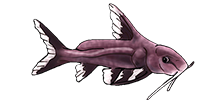
Now these fish were labelled as Peppermint, but I have had some advice to the contrary. The adult fish look exactly like the ones in the following thread.
http://www.forum.planetcatfish.com/viewtopic.php?t=2352
Chances are the fish are the exact same species as the ones in the other link.
As juvis, some have a white seam on their tail, others lake the seam. I have also noticed that this species has the spots on its eyes (not the lens or eyeball) but eyelid (for lack of a better word)
Anyway I would appreciate any ideas or input with regard to an appropriate L number.
Regards,
MC











 Note the lack of white seam. This fish started off with a white seam, only on the tail.
Note the lack of white seam. This fish started off with a white seam, only on the tail.


